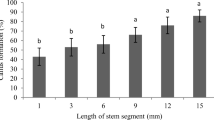Summary
The responses of two lisianthus (Eustoma grandiflorum) inbred lines and their heterotic (in vivo) F1 hybrid to different levels of benzyladenine (BA) and gibberellic acid (GA3) were studied under in vitro conditions. Number of axillary shoots developed (NAS), main shoot length (MSL), total fresh and dry weights, and extent of callus formation were measured. The two parents differed in their response to both hormones by all parameters measured. High-parent heterosis for NAS and MSL proved to be dependent on the specific BA and GA3 levels. The required BA concentrations for maximum NAS and MSL for the F1 were higher than those required for either parent; this may be defined as a heterosis in BA-requirement for maximal in vitro response. Adding 0.25 or 1 mg/liter GA3 to the medium caused a considerable increase in NAS and in dry weight gain only when combined with BA. On the other hand, MSL was increased by GA3 addition only at 0 or 0.1 mg/liter BA, but not at 0.5 mg/liter BA. Callus formation was greatly encouraged by raising the BA level from 0 to 0.1 or 0.5 mg/liter and by the addition of GA3 at low BA level. Assumed differences in endogenous BA and GA levels among the genotypes studied seemed to be related to the expression of heterosis.
Similar content being viewed by others
References
Bailey, L. H.; Bailey E. Z. Hortus III. New York: Macmillan; 1976.
Ecker, R.; Barzilay, A. Quantitative genetic analysis of growth rate in Lisianthus. Plant Breed. 111:253–256; 1993.
George, E. F.; Schel, J. H. N.; Pierik, R. L. M. The origin of bulblets formed on excised twin scales ofNerine bowdenii W. Watts. Plant Cell Tissue Organ Cult. 1:39–46; 1981.
Halevy, A. H.; Kofranek, A. M. Evaluation of lisianthus as a new flower crop. HortScience 19:845–847; 1984.
Kumar, A. S.; Reddy, T. P.; Reddy G. M. Genetic analysis of certainin vitro andin vivo parameters in pigeonpea (Cajanus cajan L.). Theor. Appl. Genet. 70:151–156; 1985.
Martinez Pulido, C.; Harry, I. S.; Thorpe, T. A.In vitro regeneration of plantlets of Canary Island pine (Pinus c). Can. J. For. Res. 20:1200–1211; 1990.
Murashige, T.; Skoog, F. A revised medium for rapid growth and bioassays with tobacco tissue cultures. Physiol. Plant. 15:473–497; 1962.
Nickerson, N. H. Sustained treatment with gibberellic acid of five different kinds of maize. Ann. Mo. Bot. Gard. 46:19–37; 1959.
Nickerson, N. H.; Embler, T. N. Studies involving the sustained treatment of maize with gibberellic acid 1: Further notes on responses of races. Ann. MO. Bot. Gard. 47:227–242; 1960.
Nour, K. A.; Thorpe, T. A. In vitro shoot multiplication of eastern white cedar (Thuja occidentalis). In vitro Cell. Dev. Biol. 29P:65–71; 1993.
Phillips, I. D. J. Apical dominance. Annu. Rev. Plant Physiol. 26:341–367; 1975.
Renata, P. Heterotic effects of somatic embryogenesis and callogenesis in some hybrids of maize (Zea mays L.)in vitro. Acta Hortic. 289:255–256; 1991.
Rood, S. B.; Pharis, R. P. Hormones and heterosis in plants. In: Davies, P. J., ed. Plant hormones and their role in plant growth and development. Dordrecht, The Netherlands: Martinus Nijhoff Publishers; 1987:463–476.
Rood, S. B.; Pharis, R. P.; Koshioka, M., et al. Gibberellins and heterosis in maize. 1. Endogenous gibberellin-like substances. Plant Physiol. 71:639–644; 1983.
Semeniuk, P.; Griesbach, R. J.In vitro propagation of prairie gentian. Plant Cell Tissue Organ Cult. 8:249–253; 1987.
Skoog, F.; Strong, F. M.; Miller, C. O. Cytokinins. Science 148:532–533; 1965.
Tamas, I. A. Hormonal regulation of apical dominance. In: Davies, P. J., ed. Plant hormones and their role in plant growth and development. Dordrecht, The Netherlands: Martinus Nijhoff Publishers; 1987:393–410.
Author information
Authors and Affiliations
Rights and permissions
About this article
Cite this article
Hecht, M., Ecker, R., Ran, S. et al. Differential expression in vitro of heterosis in lisianthus (Eustoma Grandiflorum) at various benzylandenine and gibberellic acid levels. In Vitro Cell Dev Biol - Plant 30, 136–139 (1994). https://doi.org/10.1007/BF02632202
Received:
Accepted:
Issue Date:
DOI: https://doi.org/10.1007/BF02632202




